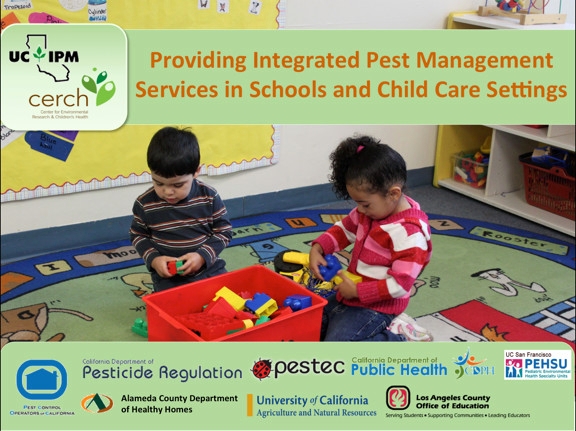New UC IPM Online Course Helps Schools And Child Care Centers Follow The Healthy Schools Act University Of California IPM 2015
Author: Cheryl Reynolds
Author: Andrew Mason Sutherland
Author: Tunyalee A. Martin
California requires that pest control companies providing services in schools and licensed child care centers comply with a series of laws called the Healthy Schools Act (HSA). The HSA promotes IPM and seeks to minimize pesticide exposure to children in all public K–12 schools and licensed private child care centers.
Providing Integrated Pest Management Services in Schools and Child Care Settings is the new free online training module available from UC IPM that explains the history of the Healthy Schools Act and details what schools, child care centers, and pest control companies are required to do to follow the law.
IPM Advisor Andrew Sutherland, Center for Environmental Research and Children’s Health (CERCH) Associate Director Asa Bradman, UC San Francisco Staff Specialist Vickie Leonard, and Luis Agurto Jr. from Pestec IPM Providers developed the training module with the input of dozens of California’s pest management professionals and child care providers, using surveys, focus groups and pilot courses. The Center for Environmental Research and Children’s Health is also developing a database of individuals who complete the course so that schools and child care centers can connect with pest control providers familiar with IPM and the Healthy Schools Act.
The online course is divided into three narrated presentations. The first presentation is about the Healthy Schools Act. The second is a section on IPM and how it can be applied to control common pests in schools and child care environments, such as ants, rodents, spiders, and roaches. The third presentation discusses how pest control companies can prosper by incorporating IPM principles and practices within their business model. IPM effectively and efficiently manages pests, builds professionalism within providers, and captures value for the customer while minimizing unnecessary pesticide applications, pesticide exposures, and associated negative impacts on children’s health, the environment, and the larger community.
The course includes the latest Healthy Schools Act requirements that went into effect on January 1, 2015. If child care and public K-12 school staff plan to apply any non-exempt pesticides, they are now required to do the following:
1) Develop an IPM plan for the school site or school district and post it either on the school’s or district’s web site or send it out to all parents and staff with the annual pesticide notice.
2) Send pesticide reports at least once a year to the Department of Pesticide Regulation for all non-exempt pesticides applied by school employees. The first reports are due January 30, 2016 and cover the period from January 1, 2015 to December 31, 2015.
Beginning July 1, 2016 any professional applicator, school IPM coordinator, and school or child care employee or other unlicensed person applying pesticides must complete annually a Department of Pesticide Regulation-approved training on school IPM and safe use of pesticides.
Licensed pest management professionals can receive two continuing education units by completing the online course: one “Rules and Regulations” and one “IPM” from the Structural Pest Control Board; and one “Laws and Regulations” and one “Other” from the Department of Pesticide Regulation.
To take the course, visit the UC IPM web site. For more information on the Healthy Schools Act requirements or forms, visit the Department of Pesticide Regulation’s School IPM web page.
Original URL: https://ucanr.edu/blogs/blogcore/postdetail.cfm?postnum=16780